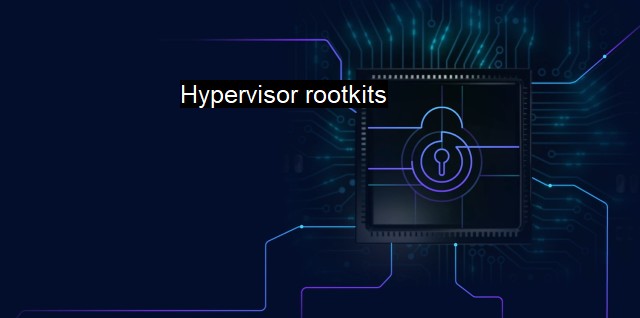What are Hypervisor rootkits?
The Perilous World of Hypervisor Rootkits: A Malware Threat to Virtualized Environments
Hypervisor rootkits are one of the most significant concerns for cybersecurity professionals. They represent a dangerous class of malware with complex mechanisms capable of harming systems at their most fundamental level. This text aims to shed light on what hypervisor rootkits are, their functionality, and the risks they pose regarding cybersecurity and antivirus programs.A hypervisor is a software layer capable of creating and controlling virtual machines, providing a separated environment between the host system and the virtual systems. Conceptually, hypervisors, like their name suggests, directly supervises and partitions the physical computer's resources to build the virtual environment. This feature is widely used across the IT sector, such as in the field of cloud computing, virtual networking, and data centers. Misusing this influential tool towards malicious purposes results in the formation of hypervisor rootkits.
Rootkits are a type of malicious software designed to provide unauthorized access or control over a computer system without being detected. They differ from conventional malware as they inject themselves into critical system areas where regular software doesn’t have access, typically lying low to maintain access and control. A hypervisor rootkit utilizes the hypervisor layer to carry out these notorious activities.
This type of malware transfers the rest of the system into a subordinate or virtualized layer beneath the hypervisor. After repositioning itself over the host and virtual systems, the rootkit applies its deceptive skills and controls the entire machine manipulatively through the supervisory hypervisor. Comparable to how puppet masters have strings to control puppets, a hypervisor rootkit plays the computer system from above without detection, delivering ultimate control of the system to the attacker.
Hypervisor rootkits' stealth and authority over systems are significant threats to cybersecurity. By relocating the operating system into a virtual machine—the territory directed by the malicious hypervisor—the rootkit cloaks itself from antivirus programs. These programs can only scan from within their allocated system environment, blind to what is happening beyond their borders.
The operating system and the antivirus programs running on it are in the very palm of the hypervisor rootkit, remain oblivious to their surroundings' reality. By achieving this level of control and evasion, malicious activities such as data theft, alteration, or deletion can be performed unabatedly. it allows the attacker to conduct persistent operations, diminishing the likelihood of detection and removal.
Another significant danger from hypervisor rootkits is their capability for "out-of-box" infection. It means that the infection can be introduced to the system in its very initial stages, even before the operating system is installed. It creates a situation where the whole system lifecycle, including every update and every reformatted disk, is subject to the rootkit, making it almost impossible to completely purge the system from the rootkit.
Having said all these, it is vitally important for organizations to ramp up security measures to combat these sophisticated types of rootkits. Efforts can be focused on employing strict patch management processes, updating hypervisor versions, periodically checking firmware integrity, and employing sophisticated vulnerability detection and mitigation techniques. Rootkit detection has always been a challenge, but companies should look into anti-rootkit tools that penetrate deeper into system levels, going to the hypervisor levels and beyond.
Hypervisor rootkits, if left unchecked, can cause catastrophic damage to systems and networks, posing severe threats to cybersecurity and bypassing antivirus protections effortlessly. The world of malware and rootkits continues to evolve, necessitating persistent vigilance and an unwavering commitment to the highest standards of cybersecurity. It highlights the significance of understanding what hypervisor rootkits are, how they operate, and their risks. With this knowledge, individuals and organizations will better anticipate, prevent, and mitigate the threats they pose.

Hypervisor rootkits FAQs
What is a hypervisor rootkit?
A hypervisor rootkit is a type of malware that infects the computer's hypervisor - a layer of virtualization software that runs below the operating system. This allows the rootkit to control and manipulate the operating system and applications, making it difficult to detect and remove.How do hypervisor rootkits evade antivirus software?
Hypervisor rootkits are designed to operate at a lower level than most antivirus software, making them difficult to detect. They can also use stealth techniques, such as encrypting the code or hiding it within unused parts of the memory. Additionally, they can disable or manipulate antivirus software to avoid detection.What are the consequences of a hypervisor rootkit infection?
A hypervisor rootkit can allow attackers to gain persistent access to the compromised system, steal sensitive data, and control the machine for malicious purposes. It can also compromise the confidentiality, integrity, and availability of the system and damage the reputation of the organization.How can organizations protect themselves against hypervisor rootkits?
There are several measures organizations can take to protect themselves against hypervisor rootkits. These include implementing security controls such as access controls, firewalls, and intrusion detection systems, keeping software up to date, monitoring for unusual activity or changes in the system, and using specialized security tools that can detect and remove hypervisor rootkits. Additionally, organizations should educate their employees on safe computing practices and encourage them to report any suspicious activity or incidents.| | A | | | B | | | C | | | D | | | E | | | F | | | G | | | H | | | I | | | J | | | K | | | L | | | M | |
| | N | | | O | | | P | | | Q | | | R | | | S | | | T | | | U | | | V | | | W | | | X | | | Y | | | Z | |
| | 1 | | | 2 | | | 3 | | | 4 | | | 7 | | | 8 | | |||||||